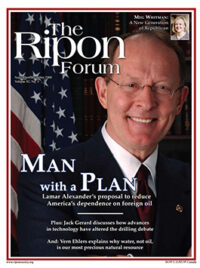In difficult economic times such as these, it can be hard to remain optimistic. But the nation’s electric power industry is. We are building for the future. And we remain dedicated to ensuring that the next generation of Americans can continue to enjoy a reliable, affordable and environmentally friendly electricity supply.

A fundamental building block for this future will be giving our customers more control over their electricity bills. Today we are doing that by promoting the use of efficient electric appliances and the construction of energy-efficient buildings. Expanding our efficiency efforts also enables us to start reducing carbon emissions today as we meet the growing demand for electricity. Our vision for energy efficiency includes developing and deploying technologies—such as advanced electric meters and “smart” appliances—that will enable real-time communication between the consumer and electric utility. This will open the door for consumers to make automated choices over how they use energy, which can lead to even greater energy savings.
The widespread use of plug-in hybrid electric vehicles (PHEV) is another aspect of our strategy to help customers lower their overall energy bills and address climate change. PHEVs are similar to today’s hybrid cars, except that they have a larger battery, and that battery can be recharged through a standard, 110-volt home outlet.
Once charged, a PHEV can drive 20 to 60 miles on battery power alone, without using any gasoline. That means less dependence on foreign oil, lower fuel costs for consumers, and lower emissions overall. The nation’s electric utilities are collaborating with automobile manufacturers, suppliers, advocacy and governmental groups, and other stakeholders to bring PHEVs to the market.
The expanded use of renewable energy resources is another critical tool we are using to help meet demand and lower our carbon emissions in the near-term. The power industry brought on line almost 6,000 megawatts (MW) of new renewable energy last year, with wind capacity alone expanding by more than 5,200 MW. This represents a 45-percent increase in the nation’s total wind power generating capacity, which makes the U.S. the fastest-growing wind power market in the world for the third straight year.
As renewables become more cost competitive, and as the transmission capacity is built that connects the typically remote locations where renewable energy resources are located with the population centers where the electricity is needed, we anticipate the use of renewables to grow even faster.
Upgrading and expending our infrastructure to meet the needs of families and businesses will require massive investments in energy efficient programs, generation, transmission, and distribution.
But energy efficiency and renewable energy resources together will not be enough to meet the country’s ever-increasing demand for electricity. We also must expand our use of coal and nuclear energy for generating electricity. Both of these domestic fuel sources will remain essential for keeping America’s electricity supply secure, reliable, and affordable.
Coal, because of its low cost and abundance, generates about half of the country’s electricity. We have begun to develop advanced coal plants that can generate electricity more efficiently. And we are beginning to develop the technologies that can capture, transport, and store carbon dioxide emissions from coal-based power plants.
Although these carbon capture technologies hold much potential, they are largely untested. There are significant cost and performance challenges facing large-scale capture technologies and permanent underground storage. As a result, they are not expected to be commercially deployable on a large scale until around 2020-2025.
Advanced nuclear energy plants will be needed to keep up with demand as well. Nuclear energy gives us our only source of on-demand, zero-emission electricity.
Upgrading and expanding our electric infrastructure to meet the needs of families and businesses will require massive investments in energy efficiency programs, generation, transmission, and distribution. Likewise, under any scenario, reductions in greenhouse gas emissions will be expensive.
With debates over climate change legislation heating up in Congress, we are advocating that any legislation adopted be aligned with the time necessary to develop the zero- and low-emitting advanced technologies we need to reduce carbon emissions. This will be vital for protecting consumers and the economy from volatile energy prices.
So, too, will be explicit cost-containment measures on the price of trading emissions under an economy-wide cap-and-trade program. Allowing for “offsets”—actions, such as planting trees and capturing methane from landfills—is another cost-effective way to reduce carbon emissions both here and abroad.
Our involvement with international clean energy projects and initiatives that facilitate the adoption of advanced, low-carbon technologies is a step in the direction of helping countries around the world to meet their environmental, as well as their developmental, goals. Clearly, without the participation of all nations—developed as well as developing—the world will not be successful in lowering carbon emissions.
Another issue on which we have begun working with Congress is an extension of the lower tax rate on dividends that went into effect in 2003. The law, which lowered the tax rate from 38.6-percent to 15-percent, will expire at the end of 2010.
The lower tax rate is important to the more than 50-percent of U.S. households who own stock in electric and gas utilities. And it is particularly important to senior citizens who represent almost two-thirds of utility shareholders.
With the massive investments needed to transform the industry ahead of us, the lower tax rate on dividends also has great significance for reducing the cost of capital utilities will need to pay. This helps keep customer costs down and reliability up.
Electricity is clearly a crucial commodity that America, and indeed the world, cannot take for granted. Regardless of the turmoil on Wall Street, America’s electric power companies remain steadfast in their commitment to delivering the strong, reliable and affordable electricity supply that the economy and the country need to move forward.
For more information on these topics and all the key issues facing the nation’s electric companies, I encourage you to visit <a href=”www.eei.org”>www.eei.org</a>.
Thomas R. Kuhn is the President of the Edison Electric Institute (<a href=”www.eei.org”>www.eei.org</a>)




